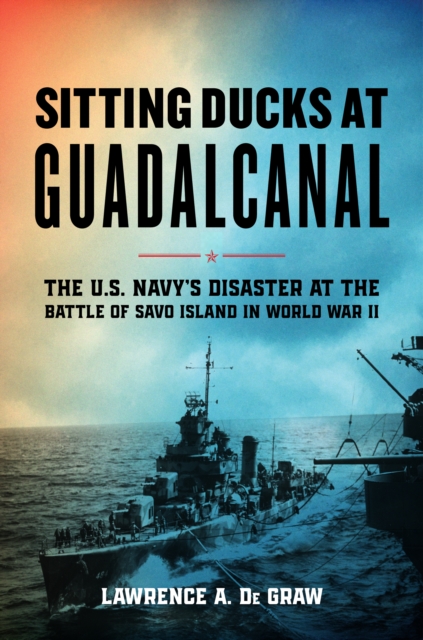Sitting Ducks at Guadalcanal: The U.S. Navy's Disaster at the Battle of Savo Island in World War II

Sitting Ducks at Guadalcanal: The U.S. Navy's Disaster at the Battle of Savo Island in World War II
On August 7, 1942, U.S. Marines waded ashore in the Solomons, defended by warships of the U.S. Navy. The amphibious landing was the first major American ground campaign of the Pacific War, intended to prevent the Japanese from establishing naval and air bases in the island chain and to establish Allied bases for future operations. Most famously--and most gruelingly--the invasion marked the beginning of the months-long Guadalcanal campaign. Caught off guard, the Japanese swiftly regrouped for a seaborne counterattack on the night of August 8-9. The result was one of the worst American naval defeats of the war after Pearl Harbor.
In this meticulous minute-by-minute retelling of the First Battle of Savo Island, Lawrence De Graw covers the navy's role in the initial landings on Guadalcanal before setting the stage for the naval clash that would come the next night. On the eighth, the American commander, fearing Japanese attacks and cautious about fuel levels, withdrew his aircraft carriers and let his cruisers and destroyers--exhausted from two days of high alert and combat--operate with only half their crews on duty. The navy was unaware the Japanese had been training to fight at night. The American ships were sitting ducks when the Japanese fleet steamed through "The Slot" between Savo Island and Guadalcanal and into what became known as "Ironbottom Sound." In little more than thirty minutes, the Japanese sent three U.S. (and one Australian) heavy cruisers to the bottom and damaged three other vessels. The American fleet withdrew from the area for the foreseeable future and limited shipments of men and materiel to the daytime, helping turn the battle of Guadalcanal into a long, hard slog.
Sitting Ducks at Guadalcanal is naval history, featuring a colorful narrative that covers the big picture as well as stories of individual vessels and sailors as well as a careful analysis of the battle and just what went wrong for the U.S. Navy off the island of Guadalcanal.
PRP: 234.00 Lei
Acesta este Prețul Recomandat de Producător. Prețul de vânzare al produsului este afișat mai jos.
187.20Lei
187.20Lei
234.00 LeiLivrare in 2-4 saptamani
Descrierea produsului
On August 7, 1942, U.S. Marines waded ashore in the Solomons, defended by warships of the U.S. Navy. The amphibious landing was the first major American ground campaign of the Pacific War, intended to prevent the Japanese from establishing naval and air bases in the island chain and to establish Allied bases for future operations. Most famously--and most gruelingly--the invasion marked the beginning of the months-long Guadalcanal campaign. Caught off guard, the Japanese swiftly regrouped for a seaborne counterattack on the night of August 8-9. The result was one of the worst American naval defeats of the war after Pearl Harbor.
In this meticulous minute-by-minute retelling of the First Battle of Savo Island, Lawrence De Graw covers the navy's role in the initial landings on Guadalcanal before setting the stage for the naval clash that would come the next night. On the eighth, the American commander, fearing Japanese attacks and cautious about fuel levels, withdrew his aircraft carriers and let his cruisers and destroyers--exhausted from two days of high alert and combat--operate with only half their crews on duty. The navy was unaware the Japanese had been training to fight at night. The American ships were sitting ducks when the Japanese fleet steamed through "The Slot" between Savo Island and Guadalcanal and into what became known as "Ironbottom Sound." In little more than thirty minutes, the Japanese sent three U.S. (and one Australian) heavy cruisers to the bottom and damaged three other vessels. The American fleet withdrew from the area for the foreseeable future and limited shipments of men and materiel to the daytime, helping turn the battle of Guadalcanal into a long, hard slog.
Sitting Ducks at Guadalcanal is naval history, featuring a colorful narrative that covers the big picture as well as stories of individual vessels and sailors as well as a careful analysis of the battle and just what went wrong for the U.S. Navy off the island of Guadalcanal.
Detaliile produsului









